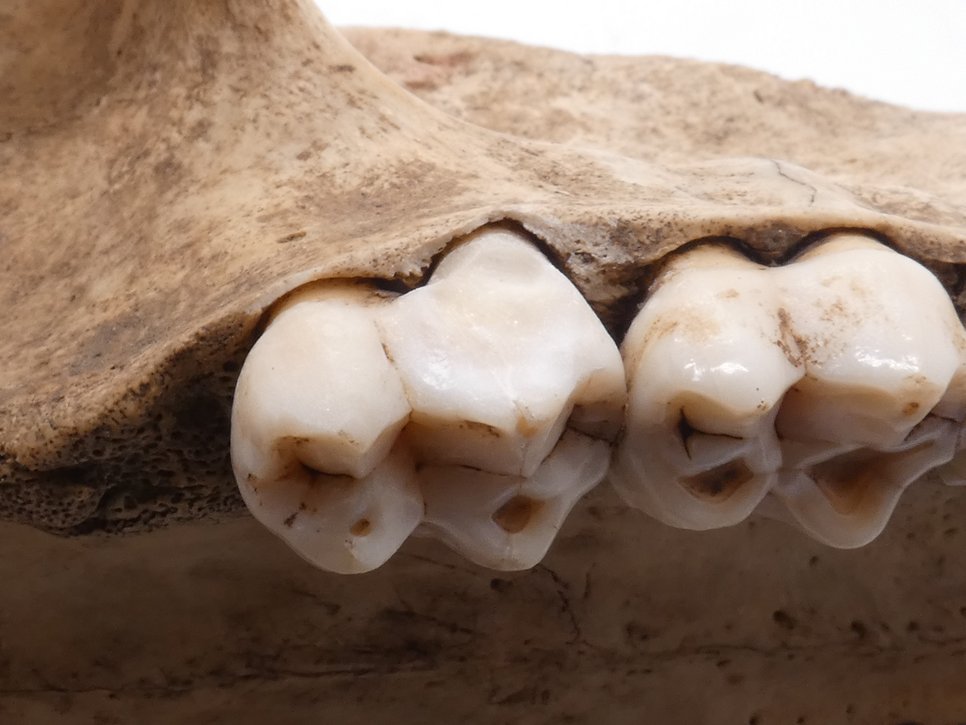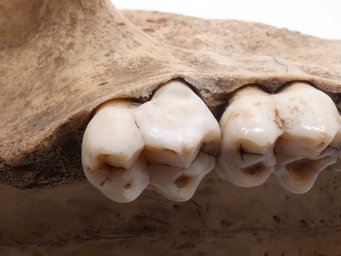Uncovering the real paleo diet: Scientific team wins HFSP Research Grant
An international research team including Tina Lüdecke from MPI for Chemistry won a Research Grant from the Human Frontier Science Program (HFSP) – Can they find a new way to look deeper into isotopic composition of amino acids in tooth enamel?
Emmy Noether Group leader Tina Lüdecke from the Max Planck Institute for Chemistry (MPIC) in Mainz, has been awarded a prestigious and highly competitive Human Frontier Science Program (HFSP) Research Grant along with Cajetan Neubauer from the University of Colorado Boulder (Institute of Arctic and Alpine Research) and Rani Bakkour from the Technical University of Munich (TUM). The three-year funding, around U.S. $1 million in total, will support the international scientific team led by principal investigator Cajetan Neubauer to work on the project "Uncovering the real paleo diet: Novel isotope analytics of amino acids from fossil hominin teeth.“ The team aims to develop a new method to measure the isotopic composition of amino acids in tooth enamel and thus get more details on the hominin diet.

“Much of our understanding of the relationship between hominin diet and evolution is based on anatomical and archaeological information derived from hominin fossils,” explains Tina Lüdecke.
Direct chemical evidence of paleodiets has also been measured, in fossil bone collagen and tooth enamel, in the form of stable carbon isotope patterns that are indicative of food intake. Proteins and amino acids are likely preserved in enamel even millions of years old and their isotopic compositions could provide specific insights into how ecosystem use and dietary changes in human prehistory shaped human biology, societies, and cultures. “Unfortunately, currently no technique exists that can reveal paleodiet signatures from fossil amino acids. This is what we want to change with our funded project”, she said.
“The winners in this year’s HFSP Research Grant Program are remarkable scientists pioneering life science research that needs international collaboration and basic science in frontier subjects – that is, investigations for which there are no prior studies,” said Pavel Kabat, HFSP Secretary-General. “I was thrilled with the proposals we received and look forward to the ground-breaking discoveries that will be revealed.”
New Method explored
“Our team hypothesizes that recent advances open a path to achieve the ultimate dream for the isotope approach to learning about human evolution: highly sensitive detection of intact fossilized metabolites and full description of the paleodietary information they record,” says Cajetan Neubauer. This international grant brings together a team that has key complementary skills in analytical chemistry, isotope analytics, and paleoanthropology, says Neubauer.
Tina Lüdecke´s group has recently developed a method to analyze nitrogen isotopes in bulk tooth enamel to evaluate early hominin meat consumption for the first time. However, amino acids analyses are very desirable to clarify which animal resources were consumed (carnivores/herbivores), if fish or mushrooms were utilized, the role of breastfeeding, and if our ancestors hunted or instead scavenged. Most importantly, enamel amino acids could provide information about the use of fire, believed to be crucial for the evolution of large brains, as cooked foods provide much more energy than raw materials.
“My team collects samples, i.e. teeth from hominins, but first of all from recent and fossil large mammals to develop and test the method and then to evaluate the results paleoarcheologically,” Lüdecke explains.
Molecular imprinting at TUM
Rani Bakkour and his team will then isolate very small amounts of amino acids from this enamel. The researchers from TUM have extensive expertise in environmental analytical chemistry, where they synthesize and evaluate highly selective materials for the extraction of aquatic contaminates. "We synthesize macromolecules that can recognize only one molecule at a time, a technique known as molecular imprinting," explains Bakkour. "We employ this technique to isolate minute amounts of contaminants such as glyphosate from complex mixtures." This method is particularly exciting in paleoanthropology. "Selectivity is a key given the very small amounts of amino acids in tooth enamel and the very small size of the precious fossil samples."
Novel isotope analysis at CU Boulder
Afterwards, Cajetan Neubauer will measure them subsequently with a newly developed isotopic technique (Iso-Orbi) in Colorado. What Neubauer has developed at CU Boulder is an innovative and powerful isotopic technique that brings isotope analysis into the realm of structural chemistry. It allows measurement of isotopic “fingerprints” in polar chemical compounds by electrospray-Orbitrap mass spectrometry. Iso-Orbi reveals the isotopic anatomy of amino acids and can thereby provide a wealth of new multi-elemental and structural isotopic information that we anticipate will be reflective of paleo diet and environmental factors.
“Our goal is to develop a new way to look deeper into fossil molecules that will transform anthropology by exploring this emerging frontier,” summarizes Tina Lüdecke.

Further information on HFSP:
The Human Frontier Science Program (HFSP) promotes international collaboration in basic research focused on the elucidation of the sophisticated and complex mechanisms of living organisms. HFSP Research Grants support innovative basic research into fundamental biological problems with emphasis placed on novel and interdisciplinary approaches that involve scientific exchanges across national and disciplinary boundaries. Read more on: http://www.hfsp.org

